How Long Should You Feed Bees In The Spring?
Posted by EAS Certified Master Beekeeper, David Burns on 16th Apr 2019
SPRING AND FALL ARE CRITICAL TIMES OF THE YEAR TO FEED YOUR BEES
(Please Forward This To Every Beekeeper You Know!)
A colony actually requires a large amount of food like any living organism. Since a hive is considered a single living organism its requirement for steady food is enormous. Bees are like humans, they live on carbohydrates (nectar/honey) and protein (pollen). Bees are healthier when they have a continual intake of pollen and nectar.
There are critical times during the year when bees need food but it is simply not available in the quantity they require. This takes a terrible toll on the your bees.
Take for example the installation of a package in the spring. Over the last week here in Illinois packages were unable to forage for food due to rain, wind and colder temperatures. Some places receive 5 inches of snow, locking the bees in their hive lacking food. To care for the new brood in the spring large amounts of stored nectar and pollen is consumed rapidly.
When temperatures fall below 50 degrees (f) the bees cluster to stay warm and are no longer able to go down and eat from the entrance feeders. More resources are consumed by the colony than normal in order to produce heat. Brood is not cared for properly due to a lack of food and less eggs are laid during cold snaps. This greatly reduces the building up of brood. There are several reasons why brooding up is so important in the spring and early summer. A large population is essential for gathering nectar, building comb, storing honey and fighting pests and diseases. Weaker colonies usually become weaker which increases the risks of wax moths, small hive beetles and winter die-outs.
Without a large numbers of foragers they will not have large amounts of nectar need to expand quickly. Without large amounts of nectar they will not be able to produce large amounts of wax to build comb. Without comb there is no place for the queen to lay. This is why it is so important that as long as your bees are drawing our frames, they must be fed.
Since we have placed a colony of honey bees in our hive, on our property and want them to work on our terms, there are critical times during the year when we must feed our bees such as in the spring when it is cooler and rainy. Also, bees need fed in late summer during the inevitable dearth period between when summer flowers are finished and before fall flowers bloom. Bees need to store up food for winter in the fall but frosts will killed off all foraging sources. No matter how good your bees are, how perfect your queen is, these are critical times to ensure your bees are well fed so their numbers remain strong in preparation for a summer harvest and for winter.
Several years ago I became overwhelmed with how many beekeepers were finding it difficult to feed their bees both protein and carbohydrates during these critical times. I remember I was at the Eastern Apicultural Society meeting in Pennsylvania when a friend of mine received a call that her bees were starving. This was in late summer during a dearth. She was in a panic to figure out how to quickly get food in the hives.
Then, I was speaking at the Tri-County Beekeepers annual conference in Ohio when another beekeeper and fellow master beekeeper told me how much he liked my Winter-Bee-Kind feeding system, but that I should make one for the summer and fall dearth.
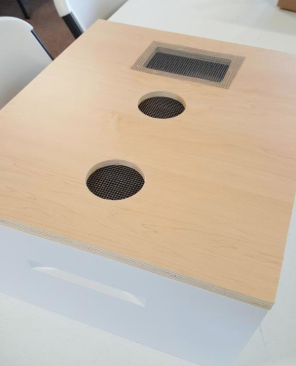
We both discussed how this is one of the more critical times that bees need to continue building up on needed resources in preparation for winter. So it took me a year of trying out different methods and systems to finally figure it out. I finally did it! It took several prototypes but I finally developed the Burns Bees Feeding System.
So often new beginners call us in a panic saying they just installed their new package but they are worried about the cold nights.
Here's the 411 on why new packages are so stressed that sometimes they never fully recover. People purchase their packages so early that the new package of bees is stuck in the hive. Snow storms, cold nights and a lack of foraging resources early in the spring causes the new package to fall behind on brood production. This can persist all through the year. All that is needed is to feed your bees from the top, NOT THE FRONT, so that when your new bees are clustered near the top, they have access to the food they so desperately need to build up fast.
Sure you may see your bees bringing in pollen but their demand for food is usually far more than they can find in early spring.
Some people try to place an entrance feeder at the entrance or on the frames of a deep and surround it with a shell of a deep hive body and place a lid on it. But when it is too cold for the bees to go down to the entrance feeder at the opening, they just stay clustered at the top. Also the bees need more than just sugar, they also need protein to keep building up.
So let me give the details the Burns Bees Feeding System. It comes with lids with pre-drilled holes for your small mouth jars. We recommend sugar water mixed 1:1 in the spring and 2:1 (2 parts sugar to 1 part water) in the fall. We discovered last year it is best to add 1 teaspoon of our protein powder to your sugar water. This helps gives the bees the protein they need. Our feeder holds in the heat during the cool nights of spring. We recommend the patties are smashed through the screen in order to create more texture so the bees can consume patties more effectively.
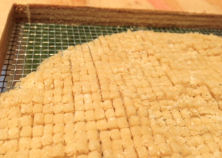
This allows the patty to be divided into tiny attached sections making it easier for the bees to consume and helps control small hive beetle infestation.
This is a view of the patties facing up, but when placed on the hive, the patty pictured above is placed upside down and hangs directly above the cluster.
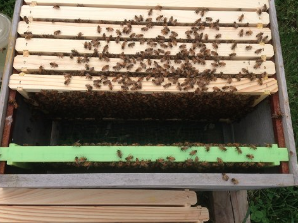
Here is a new package on undrawn foundation. A green drone comb is seen here which is excellent to help control mites. The Feeding System is placed directly on top of the cluster. Once all your frames are placed back in after installing your package our feeder provides the food your bees need to get off to a great start.
You can place a used deep on top of the feeder as a shell and place the top cover on that deep. Now you have a compartment to feed your bees and since our holes are lined with screen, the bees stay down when you change your jars. If you bought a new hive that came with 2 deep hive bodies, you can use one as a shell, because you only install your bees in 1 deep for the first few weeks.
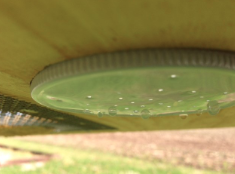
Notice how the jar lid does not allow the sugar water to spill out, but simply bubbles due to a vacuum seal of your jar. The bees are able to drink from this effectively through the protective screen.
Finally place the top cover on and be sure to use a weight like a rock or brick incase of a strong wind.
To order our BURNS BEES FEEDING SYSTEM, click here now. When you purchase products from us, you support our small, family business which allows us to continue to invent and provide awesome beekeeping equipment, so thank you in advance.

Seems like no matter where I go people recognize me from my YouTube videos on beekeeping. We now have nearly 18,000 subscribers! Many people tell me that I am their main source of beekeeping information. Over the last few years we have reached nearly 3 million people through our online videos, podcasts and beekeeping lessons. That's amazing. This is very humbling.
I receive hundreds of phone calls and even more emails per month from beekeepers around the country seeking answers on what to do next with their hive.
In 2016 I launched a new partnership program to help beekeepers navigate through their new hobby of beekeeping. As an EAS Certified Master Beekeeper (2010) I find it extremely rewarding to assist beekeepers throughout the country. I named it BeeTeam6.
For less than $5 a week here's what you will receive from my partnership program:
- Several New Instructional Videos Each Month.
- Personal Email & Phone Mentorship With Me. Once you sign up you are given my personal cell phone. You'll be just a phone call, text or email away from a certified master beekeeper to help you when you need it most. Let's face it, spring is when we need help the most.
- Picture/Video Evaluation Of Your Hive When Needed. Send me a video and/or pictures of what concerns you and I'll advise you on the next step to take.
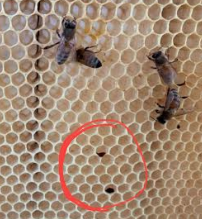
A few days ago a member sent me this photo fearing she had American foulbrood.
- I will also send you several articles a month with tips on what you should be doing and looking for and interesting beekeeping science and practical approaches.
Sign up in the month of April and receive:
- Your Choice Of 1(one) Item From Our Membership Gifts List
Below: (After 3 months subscribed)
GIFT LIST (Choose 1 after your 3 month anniversary)
- 1 Free online class or a free class at our location per year.
- 1 Free Winter-Bee-Kind
- 1 Free Burns Bees Feeding System
I'd Love To Have David As My Beekeeping Mentor.
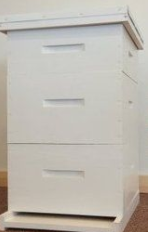
Seems like we are never expecting a swarm. When it happens we are scrambling to find something to put them in. By time we come up with something, they've flown away. Don't be that guy!
Our hives are Amish made from pine, 2 coats of exterior paint, painted aluminum top cover, screen bottom board, wooden frames with plastic foundation, beeswax coated. This is a complete hive, screen bottom board, two deeps, one honey super and all the frames. Also includes an inner cover. We know you have lots of places to buy hives, so we appreciate your support of a small, family business. Our hives are made here in Illinois.
$259 Click Here To Be Ready To Have A Hive For Swarms!
I'm glad you are keeping bees or thinking about it. Thank you for supporting our family business for all your beekeeping needs. Our hours today are 10am-4:30pm central time. Give us a call 217-427-2678
Sincerely,
David and Sheri Burns
14556 N 1020 E Rd
Fairmount, IL 61841
Long Lane Honey Bee Farms